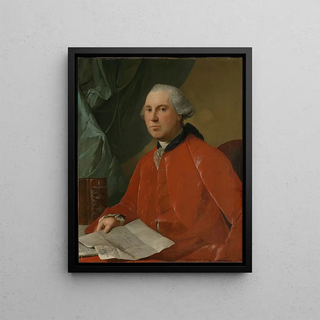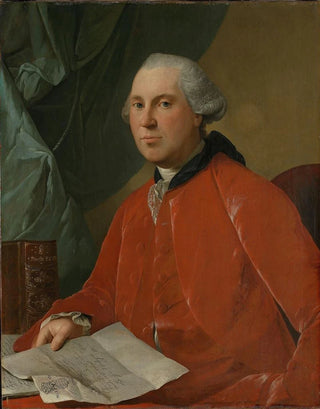Art print | Portrait of Lauritz Christian Steen - Jens Juel


View from behind

Frame (optional)
The "Portrait of Lauritz Christian Steen" by Jens Juel is an iconic artwork that transcends the simple frame of a portrait to capture the very essence of its subject. Created at the end of the 18th century, this painting bears witness to an era when portrait painting was not only a means of immortalizing faces but also a way of telling intimate stories. Lauritz Christian Steen, a prominent figure of his time, is depicted here with an intensity that invites the viewer to delve into his universe. The delicacy of the features, the finesse of the details, and the harmony of colors make this work a true masterpiece, reflecting Steen's complex personality and his era.
Style and uniqueness of the work
Jens Juel's style stands out for its striking realism and its ability to evoke deep emotions through meticulously crafted compositions. In the "Portrait of Lauritz Christian Steen," the artist uses a palette of warm, natural colors that create an intimate atmosphere. The interplay of light and shadow enhances the three-dimensionality of the face and establishes a palpable connection between the subject and the viewer. Every detail, from the penetrating gaze to the textures of the clothing, is carefully considered to offer a faithful and lively representation. This portrait does not merely freeze a moment in time; it also encourages reflection on Steen's personality, his aspirations, and his role in Danish society of the period.
The artist and his influence
Jens Juel, a key figure in Danish painting, established himself through his talent and innovative approach to portraiture. Born in 1745, he trained at the Royal Danish Academy of Fine Arts in Copenhagen, where he developed a style that combines tradition and modernity. Juel was influenced by the great European masters while incorporating elements unique to him, such as a particular attention to the expressions and postures of his models. His work not only marked his era but also paved the way for future artists seeking to capture human psychology through portraiture. By depicting figures from Danish high society, Juel contributed to shaping the artistic identity of the

Matte finish

View from behind

Frame (optional)
The "Portrait of Lauritz Christian Steen" by Jens Juel is an iconic artwork that transcends the simple frame of a portrait to capture the very essence of its subject. Created at the end of the 18th century, this painting bears witness to an era when portrait painting was not only a means of immortalizing faces but also a way of telling intimate stories. Lauritz Christian Steen, a prominent figure of his time, is depicted here with an intensity that invites the viewer to delve into his universe. The delicacy of the features, the finesse of the details, and the harmony of colors make this work a true masterpiece, reflecting Steen's complex personality and his era.
Style and uniqueness of the work
Jens Juel's style stands out for its striking realism and its ability to evoke deep emotions through meticulously crafted compositions. In the "Portrait of Lauritz Christian Steen," the artist uses a palette of warm, natural colors that create an intimate atmosphere. The interplay of light and shadow enhances the three-dimensionality of the face and establishes a palpable connection between the subject and the viewer. Every detail, from the penetrating gaze to the textures of the clothing, is carefully considered to offer a faithful and lively representation. This portrait does not merely freeze a moment in time; it also encourages reflection on Steen's personality, his aspirations, and his role in Danish society of the period.
The artist and his influence
Jens Juel, a key figure in Danish painting, established himself through his talent and innovative approach to portraiture. Born in 1745, he trained at the Royal Danish Academy of Fine Arts in Copenhagen, where he developed a style that combines tradition and modernity. Juel was influenced by the great European masters while incorporating elements unique to him, such as a particular attention to the expressions and postures of his models. His work not only marked his era but also paved the way for future artists seeking to capture human psychology through portraiture. By depicting figures from Danish high society, Juel contributed to shaping the artistic identity of the






